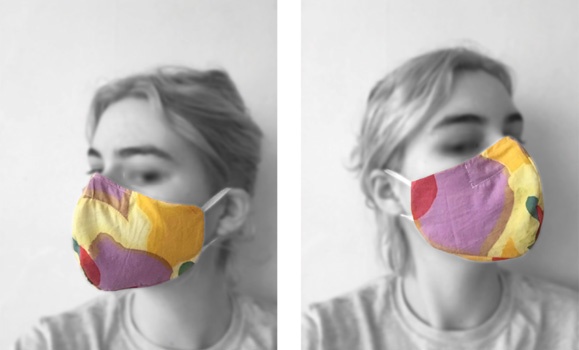It starts as a paste as thick as molasses and is being transformed by a team of scientists into a fibrous material that could be used on the front lines to protect against COVID-19.
Researchers at HÂþ» have developed a sustainable, locally produced material that can be stitched into personal protective masks to neutralize certain pathogens, such as coronaviruses and influenza viruses.
 John Frampton (shown left), an associate professor and Tier 2 Canada Research Chair in Dalâs School of Biomedical Engineering, worked with a multidisciplinary team from Dal and NSCAD University to develop the material that has a filtration efficiency of 95 per cent when placed in a cotton mask.
John Frampton (shown left), an associate professor and Tier 2 Canada Research Chair in Dalâs School of Biomedical Engineering, worked with a multidisciplinary team from Dal and NSCAD University to develop the material that has a filtration efficiency of 95 per cent when placed in a cotton mask.
The team from Dal, including members from the Department of Community Health and Epidemiology and the Department of Microbiology & Immunology, designed and tested the novel material made by dissolving powdered polymer molecules in water to form a thick paste that can be turned into a fiber when pulled and dried in the air.
Anti-viral agent added
Polymers are a class of large natural or synthetic molecules formed by linking together many smaller chemical units. They make up many of the materials in living organisms, including proteins, cellulose and nucleic acids, and also form the basis of many products we use everyday such as synthetic fabrics, glues, paints and plastic objects.
The researchers added an anti-viral agent â silver nanoparticles â to their polymer fibers, giving their filter material the ability to kill viruses that come in contact with it. In effect, a health-care worker wearing a mask fitted with the textile would be protected against viruses.
âThe idea behind the material we made is that when someone exhales vapour or aerosolized droplets containing viruses, the viruses will get trapped in the polymer fiber material, and the water vapour from their breath will partially wet the fibers. The nanoparticles that are inside all of these polymer fibers can then interact with the virus particles and essentially neutralize them,â says Dr. Frampton, who worked closely with Dr. Craig McCormickâs group in the Department of Microbiology & Immunology to conduct the virus neutralization tests.
Another benefit of the material is that it can completely dissolve when immersed in water, making it more environmentally friendly than disposable masks that are clogging waste streams. The team is also exploring the possibility of using polymers from more sustainable sources, such as crab shells or seaweed.
Sustainable PPE
Their work, which was supported through a $50,000 grant from the Nova Scotia COVID-19 Health Research Coalition, was outlined in a paper published recently in .
Dr. Framptonâs work began years ago when he was experimenting with the development of fibers from polymers and realized he needed help from someone with expertise in textiles. He got in touch with Gary Markle, a professor at NSCAD, who suggested the material could be used for sustainable surgical gowns and Personal Protective Equipment (PPE).
âAnd then the COVID-19 pandemic happened,â says Dr. Frampton. âAnd we quickly realized, âWow, we have a great opportunity here to do what we were hoping to do in the spirit of making sustainable PPE and doing it for face shield respirators or masks that people wear to protect themselves from inhaling virus particles.ââ
The discovery came at a fortuitous time since accessing surgical masks and other PPE became one of the greatest challenges in the early days of the COVID-19 pandemic, with many jurisdictions repurposing manufacturing plants to produce the critical gear.
Much of Canadaâs PPE had to be imported as well, creating delays and a reliance on foreign sources. The Dal teamâs innovation could provide a locally produced supply of PPE that can be done on a large or small scale.
âIf we ever get into this situation again where we have a pandemic respiratory virus, we now at least have some better know-how about how to manufacture these types of materials that have high efficiency filtration without having to source things from overseas,â says Dr. Frampton.
Bridging science and art
Sarah McKinnell of the Textile Department at NSCAD was responsible for doing much of the fiber production that involved physically pulling and creating the cloth used later. She also did the mock-up of the mask design that included the fiber.
âThe material for me as a textile artist is so compelling. It has the weight and drape of a high-quality silk, but acts like nothing I've ever worked with. It was really interesting to see how you can, in many ways, create a fiber from nothing,â she says.
âI found the bridging of science and art to be hugely beneficial. I think seeing the final product was satisfying, but I also feel like there is so many other places for this work to go. That's what's really exciting.â
Dr. Frampton says they are considering next steps for the project and may explore whether a company with experience in mask production is interested in the technology.

